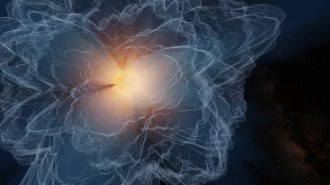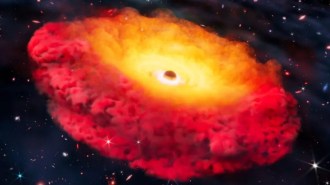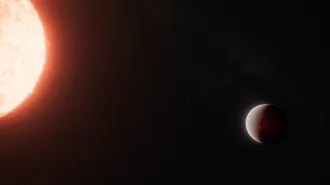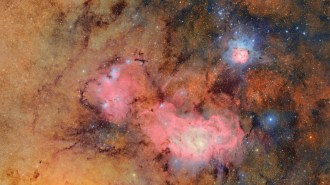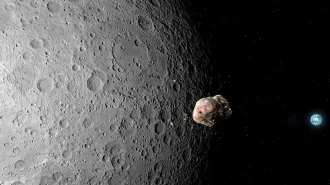Politicians may sometimes overuse the word “maverick,” but it’s an apt moniker for a highly askew chunk of ice recently discovered in the outer solar system.
The 50-kilometer–wide body, dubbed 2008 KV42, orbits the sun backwards — opposite the direction of the eight planets and every other remote body known in the solar system. Hand-in-hand with its backward motion, 2008 KV42 also has the most highly inclined orbit of any outer solar system body.
These unusual traits may provide a missing link to a family of comets, including well known Halley, whose origin has been a mystery, says co-discoverer Brett Gladman of the University of British Columbia in Vancouver, reporting the findings October 11 in Ithaca, N.Y., at the annual meeting of the American Astronomical Society’s Division for Planetary Sciences Gladman and his colleagues found the object during an ongoing survey of solar system bodies that lie beyond Neptune and that have orbits steeply inclined to the plane in which Neptune orbits the sun.The survey uses the Canada-France-Hawaii Telescope atop Hawaii’s Mauna Kea. 2008 KV42, which now lies just slightly farther from the sun than Neptune’s average distance, was quickly tracked with several other telescopes in Chile and Arizona to more accurately pin down its path.
Orbiting at full tilt, 2008 KV42 has an angle of inclination of 104 degrees, taking a sideways path around the sun compared to that of the planets. It’s the first object, aside from comets, found in the outer solar system that has such an inclined orbit. Any object that orbits at an angle greater than 90 degrees has a retrograde, or backwards, trajectory around the sun. Although no known member of the outer solar system has such a tilted orbit, many comets do, including several members of a comet family that includes the well known Halley. Theorists have been unable to find an origin for comets in the Halley family in either the Kuiper belt — a reservoir of icy bodies just beyond Neptune — or in the main part of the Oort cloud, a proposed, much more distant reservoir.The problem is that too many of the Halley-family comets have titled orbits, whereas models suggest that comets from the Kuiper belt or main Oort cloud would have a more uniform distribution of inclinations.
Gladman and his collaborators suggest that 2008 KV42 could be a transition object, a body that got kicked out of a remote region from which the Halley family of comets might have originated, but that 2008 KV42 hasn’t yet become a Halley family comet.Unlike Halley family comets, 2008 KV42 at present never gets closer to the sun than about the distance of Uranus. But the gravitational tug of both Uranus and Neptune could pull the body into the inner solar system in another few hundred million years, Gladman estimates.
This proposed source region for 2008 KV42 is the inner edge of the Oort cloud, hundreds to a few thousand astronomical units from the sun. (One AU is the distance between Earth and the sun.) The body would have been ejected from that region a few hundred million years ago, perhaps by the gravity of a passing star. “We think this is pointing to another comet source in the outer solar system” — other than the Kuiper belt and main part of the Oort cloud — that can supply high-inclination objects, says Gladman. Theorist Hal Levison of the Southwest Research Institute in Boulder says that’s a distinct possibility. The challenge now, he says, isn’t merely to find more bodies that could be transition objects with high inclinations that might have gotten kicked out of the inner Oort cloud. It is also to search for objects that are still tied to the inner part of the Oort cloud.Possible candidates are some extremely rare bodies that very occasionally come as close as 40 AU, where they could be observed by telescopes, yet still have stable paths that send them back to the inner cloud at the far fringes of the solar system.
